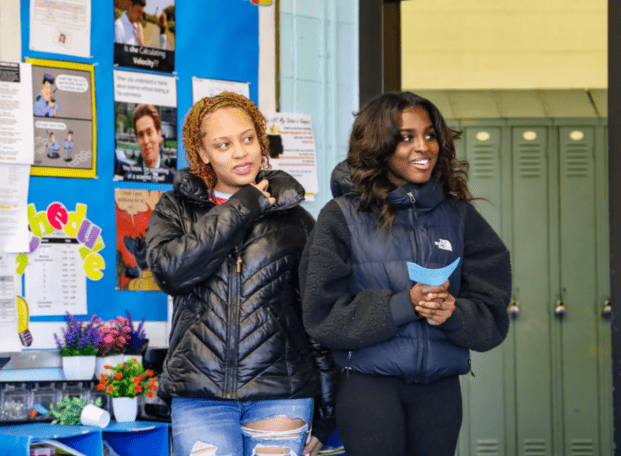Yonkers Students Leading the Way in Creating Sustainable Solutions for Stormwater Runoff

Groundwork Hudson Valley’s Green Team work on the installation of a bioretention area at Saunders High School to reduce flooding. Photo by Groundwork Hudson Valley
Submitted by Groundwork Hudson Valley
In Yonkers, New York, the threat of flooding isn’t just a distant concern — it’s a reality that affects the lives of many. With storms growing more frequent and intense, the city grapples with issues like erosion and pollution from runoff. Recognizing the urgency of addressing these environmental challenges, Groundwork Hudson Valley has taken decisive action with its “Connecting the Drops” program, funded by the EPA. This initiative empowers high school students to become environmental leaders by educating them on stormwater management, climate resilience, and nature-based solutions.
However, this initiative is more than just a classroom lesson. The program unfolds over the course of 8 sessions at each participating school, engaging students in a dynamic learning experience that combines in-classroom learning and hands-on fieldwork. Divided into two phases, the program begins with equipping students with essential knowledge. They learn about stormwater management, climate resilience, and green infrastructure concepts, laying the groundwork for the hands-on phase that follows.
The real action happens during the hands-on part of the program. Students conduct site surveys, venturing into their local environment to identify damage caused by stormwater runoff around their schools. With help from Groundwork educators, they learn to recognize and assess existing stormwater infrastructure, including components like gutters and storm drains. They gain insight into how these elements address environmental challenges and how they can be enhanced through sustainable infrastructure interventions. This practical approach helps them understand the issues better and gives them the chance to make a difference where they live. Additionally, students can connect their own experiences in these places to understand how those places are part of the larger environment and the impact they have on it.
What sets this program apart is that students take charge. Instead of just learning theory, students put their newfound knowledge to work. Students identify a site with a stormwater issue on their school campus and create a design plan to resolve it. They combine the design concepts they have learned with their understanding of how that area is (and should be) used, to create a plan that is truly local and unique to the community’s specific needs.
“This program puts students in a space that transforms working knowledge and turns it into an applied project. Students get the opportunity to positively impact their community, and leave a lasting legacy of sustainability,” said Joel Rodriguez, Groundwork Hudson Valley’s Sustainability Education Program Manager.
For many students, this program represents more than just an educational opportunity — it’s a chance to take ownership of their surroundings, draw on their lived experiences to design solutions, and effect real-world change. The projects selected move beyond hypothetical scenarios, transitioning into implementation to make a tangible impact on the community. The most feasible and impactful project is then chosen for implementation with Groundwork’s Green Team, composed of motivated high school students, stepping up to turn the chosen project into reality over the summer. Through hands-on work, they bring their community’s vision to life, transforming school grounds into resilient, sustainable spaces.
Along the way, students develop essential skills like public speaking and teamwork, setting them up for success in future careers. At the heart of this initiative are dedicated educators like Ms. Della Posta from Lincoln High School, who serve as collaborators and facilitators, enriching students’ educational experiences and nurturing their skills. Beyond the program, Ms. Della Posta facilitates the development of project skills for her students, fostering a well-rounded educational experience. School administrators also play a crucial role, working hand-in-hand to create environmentally friendly infrastructure and climate-resilient environments within their school’s campus.

Students from Lincoln High School present their design concept. Photo by Groundwork Hudson Valley.
The program is already making a difference. At Saunders High School, a bioretention area — an example of sustainable infrastructure similar to a rain garden — was implemented to reduce flooding on the soccer field. Additionally, plans are underway for two more projects at Riverside High School and Lincoln High School in the summer of 2024. With each completed project, the community’s resilience to flooding is strengthened, local water pollution is decreased, and a new generation of environmental leaders is empowered.
As the program advances, it emphasizes the crucial role of education and community action in addressing pressing environmental challenges. With Yonkers students at the forefront, they’re not only solving problems but also shaping the future of their city.
Visit groundworkhv.org for more information.





